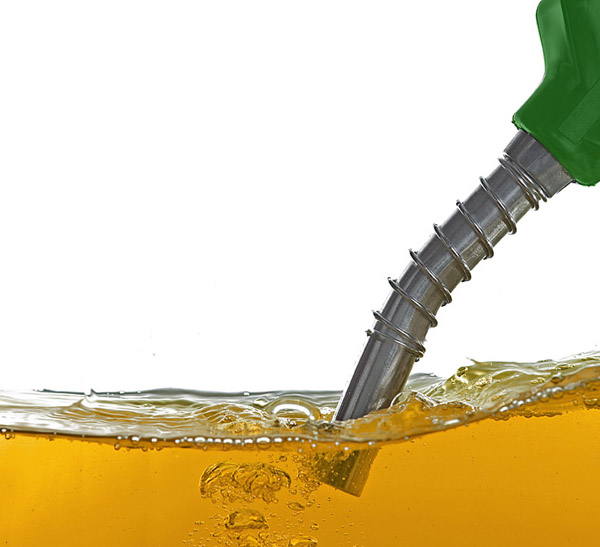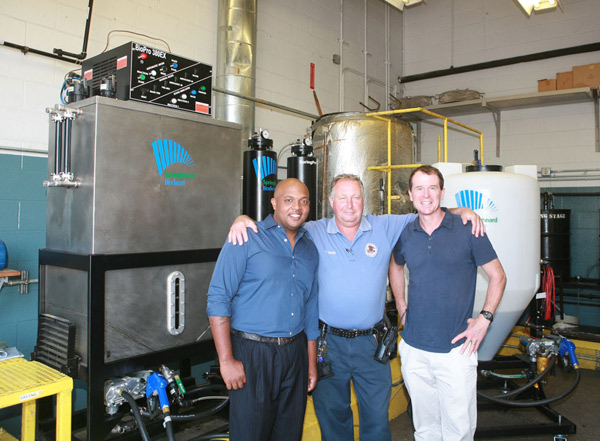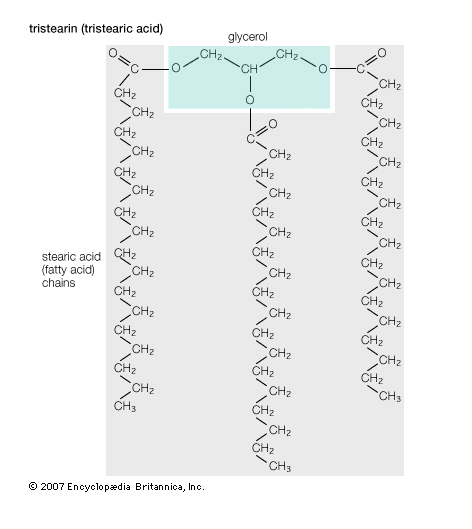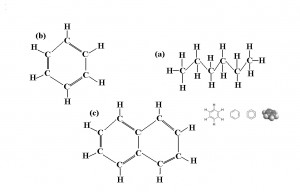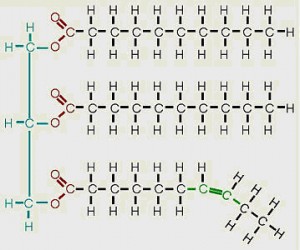Biodiesel is …great
May 28th, 2014 by matt No comments »Yes, it’s true: biodiesel is great and, arguably, even a little better than that.
Here’s why: the top 5 reasons biodiesel is …exceptional.
1. It’s Environmentally Super Friendly:
When our cars, trucks and buses burn gasoline or standard petro-diesel, these fuels emit high volumes of Carbon Dioxide and particulate matter, thereby adding to the already overwhelming volume of pollution in the earth’s atmosphere. According to multiple studies (here’s one by CARB), biodiesel made from used cooking oil emits 90% less CO2 and approximiately 50% less particulate matter than diesel when burned in a diesel engine.
2. It’s Versatile:
Biodiesel can be made from a wide variety of feedstocks (any vegetable or animal oil) including used cooking oil. Therefore, anyone from a pig farmer in WI. (pig fat converts beautifully), to an olive rancher in CA. to a restaurant owner anywhere in between, all these people and businesses have a golden opportunity, pun intended, to collect their specific “waste” feedstocks and convert it, inexpensively, into a clean-burning, renewable fuel.
3. You Will Save or Make Money By Making it Yourself:
While diesel prices remain high, making biodiesel (a fuel that will run in any diesel engine without the need to convert you engine) is inexpensive. In fact, if a casino or restaurant, school or prison, can collect used cooking oil from their dining facilities for free, and get that oil into a BioPro™ biodiesel processor, the total cost to make this fuel is 95 cents per gallon. 95 cents is the cost of all the other inputs, including electricity, if a producer can collect their feedstock oil for free. See ROI calculator
4. Biodiesel is Better For Your Engine
It is a well-known fact that biodiesel has a superior “lubricity” when compared to regular diesel. (Google it.) This means that biodiesel burns with less wear in your engine. With the advent of ultra-low sulfur diesel, many of the sulphates have been removed from diesel in an effort to make that fuel burn cleaner. With the sulfates gone, ULSD now burns significantly harder in an engine thereby reducing that engine’s expected lifespan. With the addition of even a small blend of biodiesel to diesel (B2 to B20), a diesel engine will burn with considerably less wear. Relevant info.
5. It’s Domestic and Local:
If you make it in 50 to 100 gallon batches from the feedstock you have available and use is it locally in your engine, generator or heating oil furnace, you are saying something strong to “the man” and fulfilling the command on inumberable bumper stickers.
#6. (Bonus Benefit) Job Creation
As the United States and the world contends with this economic crisis, one of the major challenges we face is job creation. Producing biodiesel can be (and has been) an excellent engine for job creation. Waste oil collection, research into alternative feedstocks, domestic crop production and harvesting, and biodiesel production all require attention and expertise. By investing in biodiesel fuels, and sparking a further increase in demand for biodiesel, we are motivating more people to get involved in a clean-tech industry that fosters energy independence and contributes to a solution for global climate change.
-Matt Roberts
Springboard Biodiesel
www.springboardbiodiesel.com
The Scariest Repo Man
September 27th, 2012 by matt No comments » There is a raging political debate that is consuming the airwaves of late – apparently 4 guys in North Carolina and 3 women in Nevada can’t tell the difference between the presidential candidates positions on…..just about everything (Early on, I was taught to avoid political discussions in new business settings, and I treat these posts as new business settings. I want the readers to evaluate the substance of biodiesel, rather than the ephemeral policy of biodiesel. So, I will attempt to employ objectivity from here on).
There is a raging political debate that is consuming the airwaves of late – apparently 4 guys in North Carolina and 3 women in Nevada can’t tell the difference between the presidential candidates positions on…..just about everything (Early on, I was taught to avoid political discussions in new business settings, and I treat these posts as new business settings. I want the readers to evaluate the substance of biodiesel, rather than the ephemeral policy of biodiesel. So, I will attempt to employ objectivity from here on).
One of the “hot buttons” of this Fall’s political debates is the need to address the crazy, unsustainable debt levels that our once triple A rated country is currently carrying. On one side of the economic divide is the group that wants to “grow” us out of debt (this entails ignoring the debt, near-term, and “spurring” growth); on the other side is the group that wants to “cut” us out of debt (this entails a substantial reduction in current government expenditures). The Latter group, in particular, implores us not to leave our children with unsustainable debts that will cripple their chances to meet, let alone, surpass their parents level of success, comfort, happiness, etc.
What’s not to like? I can believe we overspent and we need get our country’s fiscal accounts in order. There is a debt problem and curing it should be a priority. The debate about how to do so, seems reasonable (remember, I’m employing objectivity). However, the debate about our county’s finances and the argument that we are betraying future generations should also be applied to another topic that seems, inexplicably, to have fallen off the the Top Ten Chart of both the Growers and the Cutters. Neither group of “debt fixers” has the audacity to highlight our obvious, dangerous and serially ignored Environmental Balance Sheet. You see, the REAL debt debate we should be having involves our number one creditor, Planet Earth.
Now, I’m not trying to encourage you to rock out with the Grateful Dead and tell you to tread more lightly, recycle and eat more soy. I’m here to tell you that we have not only built an unsustainable debt to the environment, but that we are on a trajectory to grow that debt astronomically, AND NO ONE IS TALKING ABOUT IT AS A POLITICAL ISSUE! The stupidity and hypocrisy of ignoring climate change is beyond articulation. For those of us who pay attention to facts (and believe in evolution = critical qualifier), we know that the balance has tipped already. In thirty years, even if we were to magically transition to an all solar economy tomorrow, the planet will be hotter, agricultural regions will migrate, water sheds will change, sea levels will rise and the overall acidity of the ocean will be higher. Geopolitics will be radically different and less stable; today’s naysayers will either have exited stage right or be denying that they were deniers, and later generations will curse our selfish inaction.
You see, the earth’s environmental systems move methodically. Geologic time is radically out of sync with Human time. Battleship Earth has already received her instructions – 400ppm of CO2 in the atmosphere as of May 31st of this year – and nothing we do now will change the impact and direction of the systematic climate change that will occur as a result of today’s 400ppm CO2 “instruction set”. All we can do is try and manage those changes and take steps, now, to bring future GHG emissions down – pay our debts – and change the trajectory of environmental wreckage that follows increases in average global temperatures.
To fix the financial debt problem is important, of course. But to have a debt free nation on a planet that is measurably less livable remains a significant “downgrade” for our children and grandchildren.
Importantly, financial downgrades can be addressed and weathered. GM, that stalwart of CAFE-fighting, market share losing automotive intransigence, has taught us that in the financial world even bankruptcies can be “cured” and cured quickly. Unfortunately, environmental “cures” take a long time and they don’t make exceptions, turn blind eyes or play favorites.
For me, a CEO of an alternative energy company and a father of 3 three future super heroes, this issue is so obvious that I get headaches just reading about the rank stupidity espoused by so called climate change deniers like Jim Inhofe or by Big Oil that sees our salvation as more drilling, cheaper oil and higher CO2ppm counts – REALLY?
If you’ve gotten this far, perhaps the most important advice I can leave with you is to read Bill MckKibbon’s article: //www.rollingstone.com/politics/news/global-warmings-terrifying-new… Take 20 minutes and read his thoughtful, fact-filled article and then decide to whether or not you think Environmental Issues should be something important to the US and global policy debate.
If we continue to ignore the debt we owe the environment, “little” issues like national solvency will pale in comparison to the actions of Mother Earth’s Repo Man.
Mark J. Roberts
Springboard Biodiesel, LLC
The Cure for Diesel™
341 Huss Drive | Chico, CA 95928 | 530.894.1793 – tel | 530.894.1048 – fax
www.springboardbiodiesel.com | //twitter.com/springboardB | skype:mjroberts27 | www.biodieselisgood.org
Just Got Back From Prison
August 16th, 2012 by Matt Roberts No comments » I just returned from a federal prison in Maryland.
I just returned from a federal prison in Maryland.
I was “in” for 4 days training inmates on how to make biodiesel in an appliance we make called The BioPro™.
It turns out that there are 116 Federal prisons in the United States and, by law, all of the estimated 210,000 inmates therein interned must be sustained and kept alive with food. As is the case with all dining facilities, a prison will always generate used cooking oil in the process of feeding their inmates. That used cooking oil, fats and all, can be poured into our automated BioPros™ and, with the press of a button, converted easily into premium grade biodiesel fuel.
‘So what,’ you say?
This is the “what”: A prison can do this for 90 cents per gallon! Such is the cost of all of the inputs and electricity required to make the biodiesel in a BioPro™. Considering that biodiesel is a fuel that will run in any diesel engine, neat (B-100) or mixed with diesel, without any need to convert the engine, and further noting that biodiesel burns approximately 80 to 90% cleaner than regular diesel, you have a rather emphatic win here. The recycling of tax dollars into domestically made renewable fuel at a fraction of the cost of petroleum diesel, in a machine made in the USA. (…want ice cream with that pie?)
The Prison in Maryland was extremely clean. There was a high-security section where the meaner felons were kept and there was a low-security section where the white collar criminals with more manageable sentences were held. The latter, called “the camp”, was where the garage and the biodiesel production was located. The Camp didn’t have an outer wall to keep inmates in.
“What stops them from fleeing”? I asked the garage foreman affectionately referred to as “Smitty” by the inmates.
“They know it’s not worth it,” said Smitty. “We’d eventually find them and their sentences are too short to bother.” Better to wait it out.
The five guys who were assigned to making biodiesel were there because they were truly interested and wanted to learn.
“These guys have nothing but time.”
I asked Smitty what these guys were in for. He shrugged and said, “Drugs.” Anything else, I asked? Long pause. “No, just drugs,” he said. Later, when we were weighing out chemicals, I noticed that these guys could load up 3060 grams of Sodium Hydroxide with alarming alacrity.
There is nothing like free labor. (Actually inmates were paid 40 cents per hour).
Smitty and his assistants had made biodiesel before, in a machine made in Costa Rica, and when they discovered how easy it was to use the BioPro™, they were visibly excited.
The machines, since they are automated, reduce labor tremendously but they still need to be loaded and unloaded and inputs need to be managed. When they weren’t working with the equipment, the inmates could make soap from the glycerin byproduct, or they could sit around on old office chairs watching and talking. On the final day, to make sure they’d been paying attention, I gave them a quiz. They all knew the answers. They’d paid attention and actually wanted to know. One inmate, a guy we referred to as “Morpheus” (as in “The Matrix”), told us he’d be out in a month and asked if there was work in biodiesel. I told him the industry was young, misunderstood, but growing none the less.
Holding up a beaker of finished biodiesel that had come out of the equipment 9 hours after they’d started a batch, Smitty the foreman cut in, “this is freakin’ beautiful fuel.”
-Matt Roberts
SB
Matriculating this Fall at a Campus Near You: Biodiesel!
July 21st, 2011 by Mark Roberts No comments »I have recently been talking to a lot of college, university and even high school administrators, and I am optimistic the upcoming school year will see a surge in small-scale biodiesel production at the campus level. There are plenty of good reasons for this increased focus on biodiesel. Allow me to enumerate just a few of these, after which I am happy to share with you – in a one-on-one (or communal) head thumping Eureka moment – the logic, the elegance and the timeliness of Campus Biodiesel and how these factors combine in a veritable fire of logical potentiality. (No stranger to the ivory tower experience, I have taken the liberty of utilizing an oft relied upon study aid: Cliff Note: It really does make so much sense).
1. Over 700 colleges and universities have signed the American College and University Presidents’ Climate Commitment (//www.presidentsclimatecommitment.org/). This is an impressive initiative which is helping to accelerate progress towards climate neutrality and sustainability. The signatories of this document have committed to actively work towards achieving a carbon neutral footprint as soon as possible. Importantly, using biodiesel is a huge accelerator for these colleges and universities, as every gallon of biodiesel used in place of diesel reduces your CO2 emission by up to 90% (California Air Resource Board – GREET Pathway for used cooking oil as feedstock for biodiesel production://www.arb.ca.gov/fuels/lcfs/092309lcfs_uco_bd.pdf) and reduces particulate matter emissions – the stuff that is considered highly carcinogenic (source: //www.cancer.org/Cancer/CancerCauses/OtherCarcinogens/Pollution/die…) by almost 50% (EPA).
Cliff Note # 1 = “Biodiesel is good and heathy.”
2. In an era of slashed budgets and high energy prices, small-scale biodiesel represents a funding source for schools. They are able to turn their used cooking oil – which they often pay to have removed from campus – into ASTM-grade biodiesel for less than $1.00/gallon (assuming you operate one of Springboard Biodiesel’s BioPro™ biodiesel processors). In California, as of June 30th, that means they save over $3.00 per gallon of biodiesel produced. The more you make; the more you save; the faster the payback on the machine.
Cliff Note #2 = “Biodiesel saves you money.”
3. Many academic institutions are implementing Sustainability Curriculums, and their small-scale biodiesel processor can be incorporated into any class on biofuels.
Cliff Note #3 = “What a great teaching tool!”
4. Most school campuses employ diesel powered vehicles and/or equipment that can run on biodiesel (see #2 above).
Cliff Note #4 = “Saves Money, again.”
5. College students are increasingly active in asking their organizations to take concrete steps to address the climate change issue, and biodiesel is a viable and valuable first step.
Cliff Note #5 = “Our customers demand it.”
Institutions of higher learning are built to innovate. On the environmental front, colleges, universities and K-12 institutions are actively working to make a difference, and as a result biodiesel is becoming mainstream. Give us a call and let’s talk about how you can join over 56 of your colleagues (//www.springboardbiodiesel.com/biodiesel-for-colleges-and-universities) in the growing movement to benefit from small-scale biodiesel production.
Cliff note Summary: “Call Springboard Biodiesel to learn how to become a campus hero.”
Mark Roberts
Gourmet Biodiesel – The Next Big Thing at Your Local Restaurant
June 8th, 2011 by Mark Roberts No comments »I’m just back from the [other] NRA show, where no guns where needed, but a healthy appetite was demanded. It was Springboard Biodiesel’s first National Restaurant Association conference, and we were impressed. Thousands of restaurant owners and hundreds of companies that sell to those restaurant owners were collected together in a sea of stainless steel equipment, free food samples and innovative restaurant ideas. Springboard Biodiesel was there to inform restaurant owners from all over the world that they had a new and essential restaurant appliance option – the BioPro™ biodiesel processing appliance. Give that restaurants are the world’s primary producer of waste cooking oil, and given that waste cooking oil is an outstanding feedstock to turn into biodiesel, restaurants have the unique ability to produce a valuable fuel commodity from a less valuable (essentially free) waste stream. With the economic metrics of “Gourmet Biodiesel” (our tagline for the show), a biodiesel appliance can substantially enhance a restaurant’s overall profitability and elevate it’s environmental marketing cache. As such, we argued – politely – every restaurant should consider owning this appliance – “You have your refrigerator, your oven, your dishwasher and your biodiesel appliance, and only one of them writes you a check every time you press start”. The response from the conference was outstanding, as both large (800 unit chains) and small (single restaurant) operators enthusiastically peppered us with questions and comments. All of them recognized the inherent advantage that they had in this waste-to-fuel arena, and given that we’d brought our shiny BioPro™ 190 with us, they had the opportunity to see and touch the appliance and better visualize how it might fit in their specific locale. The restaurant industry is huge. It’s progressive, and it values profitable innovation. We thoroughly enjoyed our first NRA show. We met some impressive restauranteurs and we further strengthened our understanding of how restaurant owners can simply and profitably create biodiesel from their used cooking oil. The restaurant industry is full of innovative entrepreneurs, who recognize an opportunity when its presented. We’re going to like working with these guys.
Old Biodiesel, Sediment, and Ultra Low Sulfur Diesel (ULSD)
March 16th, 2011 by matt No comments »
Daniel Bowen Senior Chemical Engineer at Springboard Biodiesel
As you all likely know, biodiesel is a wonderfully biodegradable substance that typically breaks down quickly in the environment. While this is a good thing, it has its downsides too. Most notably, the fact that biodiesel is much more susceptible than petroleum diesel to microbial attack and oxidation. As biodiesel decomposes, it forms acidic compounds (giving it a rancid smell) as well as many small polymer chains and large chemical compounds that are typically somewhat polar. (The polarity of molecules is one of the largest factors that determine if they will dissolve in a particular solvent or not. Polarity in a molecule is caused by uneven electrical charge distribution. One can think of polar molecules as being somewhat like little magnets wanting to stick together and non-polar molecule as being like little pieces of gravel that don’t have a strong affinity for one another.) If this course goes too far, sediment (composed of these polymers and large molecules) will begin to form.
A logical supposition to make when there is some biodiesel that seems aged would be to blend it with petroleum diesel to dilute it and then burn it that way. Unfortunately though, this is actually a very bad thing. Due to the fact that biodiesel is slightly polar, it is able dissolve many of the large molecules which are slightly polar as well. In solution, these molecules are typically able to be successfully burned in a diesel engine.
Upon mixing with USLD though, something terrible happens. Because ULSD is very non-polar, (even much more so than typical LSD) the compounds that used to be dissolved in biodiesel fall out of solution. In some cases , this can form a large amount of precipitants and sediment. If you do this in your fuel tank, you are likely to almost immediately get some clogging in your fuel filters.
If you want to see this same type of phenomenon occur in a test tube, dissolve 1 part veg oil in 10 parts isopropyl alcohol. The nonpolar oil is able to dissolve somewhat in the medium-polarity isopropyl. Now add 2 parts water to the solution. All of the sudden, the oil falls out of the solution because the highly polar water kicks it out. It is a classic demonstration of how a change in polarity of the solvent can cause solutes to precipitate out of it.
So how can you keep this from happening in your fuel tank. One strategy would be to mix the old biodiesel with ULSD in a separate vessel, and then filter or settle out the sediment. Another would be to try to treat the biodiesel in question with magnesol. We have seen good results in using this product to remove polar contaminants and allowing the fuel to be burned without problems.
The best thing of course, is to prevent the fuel from oxidizing to begin with. Blending it with petroleum diesel or adding a little bit of stabilizer (//www.springboardbiodiesel.com/springboard-biodiesel-oxidative-stabilizer) can mitigate this potential problem.
In conclusion, any fuel ; petroleum based or not will eventually degrade. Because it is biodegradable, biodiesel will typically be prone to this degradation even more so than petroleum based fuels. With a few simple precautions however (more on this in future posts) problems that could be associated with this can be easily avoided. And even if fuel is somewhat oxidized it can be effectively salvaged.
Effect of Fatty Acid Structure on Biodiesel
October 18th, 2010 by Daniel Bowen No comments »Here at Springboard Biodiesel, we hear a lot of questions and erroneous information about what type of feedstocks can be successfully turned into biodiesel. The following “1000 words or less” should hopefully clear up a little bit of that. Note that the following post does not take into account impurities such as water and FFA content of various feedstocks.
To begin with, the primary stuff that feedstock is made from is triglycerides. These triglycerides are composed of three long fatty acid chains attached to a glycerol molecule. Note that as shown in the figure below, the glycerol is only a very small part of the triglyceride molecule. Most of the bulk of the molecule (as well as the energy contained therein) is in the long hydrocarbon chains called fatty acid chains that are attached to it. As long as an oil or fat has this basic structure, it is a good candidate for being turned into biodiesel.
Are there any oils that don’t have this structure?
Sure! Take a look at some of the medley of things that you might find in petroleum diesel fuel.
Because the biodiesel reaction primarily happens at the points where the fatty acid chain meets the glycerol, the molecules shown above would obviously not be able to be turned into biodiesel.
Therefore, the primary factor of an oil or fat that determines if it can be turned into biodiesel is if it was initially composed of triglycerides. There are some natural oils such as orange oil that are not composed of triglycerides. Typically though, these are only found in trace quantities. Most natural oils that can be found in bulk are triglycerides. The following are some commonly asked questions that relate to this fact and further explain its ramifications.
1- What about saturated fats? Saturated fats are simply a specific type of triglyceride that has no double bonds along the carbon chain. The triglyceride example shown above is actually a saturated fat. Saturated fats can make excellent biodiesel. One drawback of biodiesel made from saturated fats is that it typically has a high melting point. Therefore, they are often solid at room temperature. We tested crude palm oil in our shop BioPro 190 at one time and had to literally use a shove to scoop the solid pieces of oil and put them into the machine. We then had to turn on the manual heaters to melt the oil before we could begin the process. It is also worthy of note that the solidified feedstocks will often be holding in suspension large amounts of water or contaminants that should be removed before processing. Also, the biodiesel made from saturated fats will tend to have a high melting point. Therefore, a biodiesel user may experience cold weather gelling of fuel. On the up side, biodiesel made from saturated fats will typically have a better oxidative stability and fewer NOx emissions than one made from unsaturated fats.
2- What are unsaturated fats? Unsaturated fats are fats or oils in which one or more of the carbon to carbon bonds in the fatty acid chain, is a double bond. Monounsaturated fats have only one double bond in the chain while polyunsaturated fats have more than one double bond. Below is an example of a monounsaturated fat.
The more highly unsaturated a fat is, the lower the gel point typically is. Therefore, unsaturated fats are excellent for cold weather biodiesel production and use. The downside of unsaturated fats is that they will often be more prone to oxidation and rancidification than their saturated counterparts. Typically, biodiesel made from highly unsaturated fats will require an oxidative stabilizer to be used safely as fuel.
3- What about trans-fats? Trans-fatty acids are fats and oils with a double bond in the carbon chain that is turned the other way than the typical cis-double bond. It is called a trans-double bond; hence the name trans-fatty acid. They are formed from intense heat of frying and from the process of partially hydrogenating unsaturated fats.
4- What are hydrogenated oils? Hydrogenated oils are oils in which atoms of hydrogen have been added to the vicinity of the double bond. This converts it to a single bond. A molecule of oil in which all of the double bonds have been hydrogenated is chemically identical to a standard saturated fat.
5- Can biodiesel be made from hydrogenated fats or trans-fats? Absolutely. A hydrogenated fat is chemically the same as a saturated fat. While trans-fats are thought to be bad for your health, they have no ill effect on the biodiesel reaction.
6- What are some examples of fats and oils that can be processed into biodiesel.
a) Beef tallow, coconut oil, palm oil, pork lard, and chicken tallow are all examples of feedstocks that are high in saturated fats that have been successfully utilized in biodiesel production. There is typically very few difficulties with oxidative stability for these feedstocks, however, their use often poses significant hurdles due to their high gel point.
b) Canola oil and olive oil typically monounsaturated and have very few issues with oxidative stability. They also tend to have a low gel point. These are often the most trouble free feedstock sources for biodiesel production.
Soy oil, corn oil, sunflower oil, various fish oils, rice bran oil, and hemp oil, are example of oils that are often quite highly unsaturated and will nearly always require the use of an antioxidant or stabilizer prior to use to avoid problems with polymerization and rancidification
Written By Daniel Bowen, Senior Chemist at Springboard Biodiesel
A TON of CO2
September 15th, 2010 by galen No comments »I just got back from a great vacation. I was out all of last week (plus the weekends on either end), driving, hiking, and biking through and camping in the canyons and plateaus of southern Utah.
We drove my 27 year old Landcruiser, which spends most of its time burning biodiesel, but which had to be fed a lot of petroleum diesel on this trip since we were so far from home. I did manage to stuff 22 gallons of biodiesel in the tank before I left, as well as bring another 5 gallons in a gas can, but by the time I got back home, I had purchased an burned an additional 134 gallons of petroleum diesel. I do get a tad better fuel mileage with petroleum diesel, and so I was quite pleased with the fuel mileage I did attain. My rig, loaded down like the Joad-mobile from the Grapes of Wrath and with coefficient of drag of a cinder block, averaged a hair under 20 mpg, and hit 21 mpg from Cedar City to Tonopah on the way home.
But after patting myself on the back for this achievement (not real great for a Prius, but it’s all relative), I wondered just how much CO2 I had actually emancipated into nature during our 10-day outing.
134 gallons of petroleum diesel weighs, on average 422 kg, or 930 lbs., a bit under a half of ton. But by burning up this fuel, it turns out my beast managed to spew way over a ton of CO2 into the atmosphere. How so?
Well, again on average, each gallon of diesel fuel contains about 226 moles of carbon. (For those whose recollection of chemistry class is a bit foggy, a mole is a huge number of atoms, specifically 6.02 x 10^23, which is, incidentally, referred to as Avagadro’s number. Since a carbon is so tiny to begin with, speaking in terms of moles rather than in terms of numbers of actual atoms brings quantities of these atoms into a realm that we can actually relate to.) Each mole of carbon weighs roughly 12 grams. So each gallon of diesel fuel has 226 moles X 12 grams/mole = 2712 grams of carbon.
CO2 is formed in the combustion process, when each carbon atom joins forces with two oxygen atoms. A mole of oxygen weighs around 16 grams. So a mole of these CO2 atoms weighs 12+16+16 grams = 44 grams.
So then, if each gallon of fuel has 226 moles of carbon that are burned and converted into CO2, you wind up with 226 x 44 grams/mole = 9944 grams (21.91 lbs) of CO2 produced per gallon of fuel. So for my little excursion which consumed 134 gallons of diesel fuel, I pumped a grant total of about 2936 lbs of CO2 into our atmosphere, almost 1.5 tons.
Now, this is a simplified calculation. The actually carbon content of diesel can vary a bit, a some carbon is emitted as carbon monoxide, unburned fuel, aromatics, and VOC’s, and thus isn’t converted into CO2. These factors, though are relatively minor, in fact my calculation is conservative compared to the EPA’s number of 22.3 lbs of CO2 per gallon of fuel burned.
I don’t care who you are, how much concern you do or don’t have for the environment, or how concerned you are or aren’t about global warming, that’s an awful lot of CO2.
On average, burning biodiesel that is made from recycled feedstocks reduces net CO2 emissions by about 19.3 lbs per gallon. (Even if I’d have burned soybean oil based biodiesel, it’d still be a reduction of nearly 17.3 lbs per gallon). So if I’d burned 134 gallons of our RVO based biodiesel, rather than the petroleum diesel I bought at the pump, I’d have reduced my net CO2 emissions by 2586 pounds, well over a ton. (I would’ve also saved about $300 as well).
Then again … I suppose it could’ve been worse:
